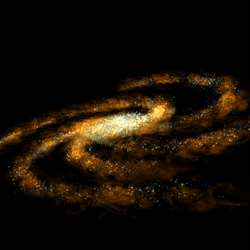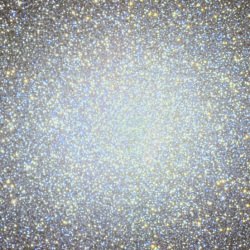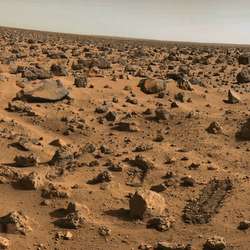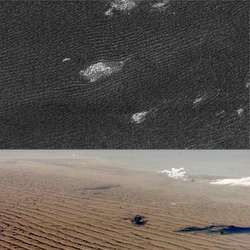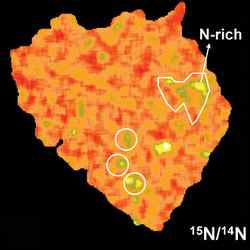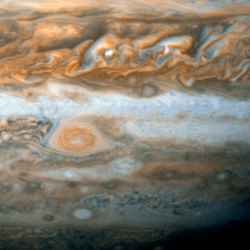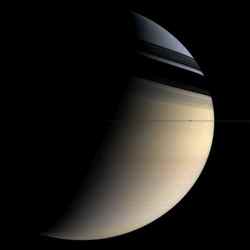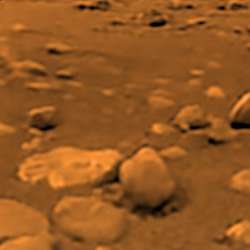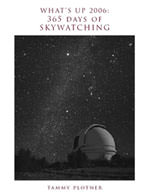
Download our free “What’s Up 2006” ebook, with entries like this for every day of the year.
|
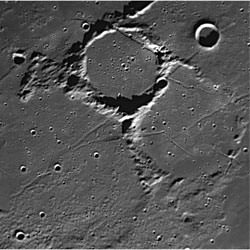
Fra Mauro. Image credit: Fra Mauro. Click to enlarge.
Greetings, fellow SkyWatchers! “There’s a bad Moon on the rise”… But that won’t keep us from viewing historic lunar areas such as the captivating Fra Mauro and catching bright clusters and double stars! Come along and join us a we take a look at what can be seen this week, because…
Here’s what’s up!
Monday, May 8, 2006 – A little more than 35 years ago, the Apollo 13 crew was on a mission to land in the Fra Mauro highlands. Although a near-disaster kept the crew from completing the mission, Apollo 14 carried out the plan less than a year later. Tonight we will be able to see this landing area on the lunar surface. Along the terminator to the south, you will see a dark expanse known as Mare Nubium. On its northern shore and near the terminator’s center, you will see an inlet of small shallow craters. The brightest of these small rings is crater Parry with Fra Mauro appearing larger and shallower to its north. Power up! Fra Mauro has a long fissure running between its north and south borders. At the northern crater edge you will see the ruins of an ancient impact. Appearing as an X, it definitely marks the spot of this successful lunar landing.
Tonight let’s use binoculars to hunt down a large open cluster – Melotte 111 – northwest of Arcturus. Like other visible clusters such as the Hyades, Pleiades and Praesepe, this Coma Berenices star cluster has a place in history. Known as the “Queen’s Hair,” it was first noted by Ptolemy. In more recent times, R.J. Trumpler identified 37 stars in Melotte 111 that share common movement. This discovery revealed the Coma Berenices cluster as a true group and not just a random collection.
Satellite observatories, like ESA’s Hipparcos, show us the members of Mel 111 are located around 288 light-years distant, making it one of the closest clusters in the heavens. Of the 37 stars identified by Trumpler, the brightest is 4.35 magnitude Gamma and the faintest members range to magnitude 10.5. Of the 400 stars gathered in this region, only about 129 are not true members of the group.
Tuesday, May 9 – Today in 1962, the first Earth-based laser was aimed at crater Albategnius. While the terminator has moved well beyond its position, you can still pick it out of the jumbled landscape. Look centrally on the lunar surface for the small, heart-shaped, grey area known as Sinus Medii. Just south of it lie a pair of prominent craters, Ptlomaeus to the west and Albategnius to the east.
The Moon will also offer many features such as the fully disclosed Tycho, the incomparable Copernicus and the fascinating Bullialdus, but tonight we’ll be looking for “The Great Wall.” Start by drawing a mental line from Tycho to Copernicus, then extend that line by two-thirds the distance north. Here you will discover what looks like huge wall on the lunar surface. At 48 kilometers high and 161 kilometers long, that would be a great wall! It is nothing more than the western portion or the Juras Mountains surrounding the lovely Sinus Iridum, but it’s definitely a rather striking feature and well worth the time to look in both binoculars and telescopes. Klare nacht!
Ready for more? How about another unexpected “open” cluster? Then look at Ursa Major. The primary stars – Merak, Phecda, Megrez, Mizar, and Alioth – have their own designation. Known as Collinder 285, it was first recognized as a cluster by R.A. Proctor in 1869. The Ursa Major “Moving Cluster” is headed south and east toward a spot in Sagittarius (RA 20:24 and Dec -37). The center of Collinder 285 is located 75 light-years away and its most distant bright member is outlying Alpha Coronae Borealis. The stars in this group are very similar to those in the Hyades – giving a cluster age of roughly 750 million years. Motion studies of over 100 stars throughout the sky (including Sirius, Alpha Ophiuchi, Delta Leonis, and Beta Aurigae) all show a similar “drift” across the heavens at a speed of almost 50 kilometers per second. That’s faster than the average speed of Mercury orbiting the Sun!
Wednesday, May 10 – Tonight bright Spica will join the Moon – making a very close appearance for some – and an occultation for others! Be sure to check IOTA for details. The most prominent lunar feature will be the ancient and graceful Gassendi. Its bright ring stands on the north shore of Mare Humorum – an area about the size of the state of Arkansas. At 113 kilometers in diameter and 2012 meters deep, you will see a triple mountain peak in its center and the south wall eroded by lava flows. Gassendi offers numerous fine details to telescopic observers on its ridge and rille covered floor.
When you have finished your lunar observations, let’s revisit a fascinating double star and try a simple experiment. Center your scope on Cor Caroli and watch as the “Heart of Charles” drifts west. The warm yellow primary is a magnetic spectrum variable and the pale blue secondary makes watching this 120 light-year distant pair pure pleasure. Now wait two and a half minutes as widely separated double Struve 1702 comes into view. Now that’s finding faint double stars made easy!
Thursday, May 11 – Tonight’s lunar observations will be a challenging study worthy of larger scopes. Start by identifying previous study craters, Hansteen and Billy. Due west of Hansteen you will find a small crater known as Sirsalis near the terminator. It will appear as a small, dark ellipse with a bright west wall along with its twin, Sirsalis B. The feature you will be looking for is the Sirsalis Rille – the longest presently known. Stretching northeast of Sirsalis and extending 459 kilometers south to the bright rays of Byrgius, this major “crack” in the lunar surface shows several branchings – like a long dry river bed.
Tonight let’s go from one navigational extreme to another as viewers in the northern hemisphere try their hand at Polaris. As guide star for the north, Polaris is also a wonderful double with an easily resolved, faint blue companion. But what about the south? Viewers in the southern hemisphere can never see Polaris – is there a matching star for the south? The answer is yes. Sigma Octantis. But at magnitude 5, it doesn’t make a very good unaided eye guide.
Ancient navigators found better success with the constellation Crux – better known as the “Southern Cross” – to guide them. Two bright stars of the Southern Cross, Gacrux and Acrux, are oriented north-south and point across the pole to brilliant Archenar. Splitting the distance between Gacrux and Archenar puts you within two degrees of the rather desolate south pole of the sky. Southern hemisphere observers wishing to see a double star comparable to Polaris in appearance should choose Lambda Centauri. The difference in magnitude between components and separation are about the same.
Friday, May 12 – The Moon and Jupiter rise tonight shortly before the Sun sets. Despite lunar surface brightness, we can do some exploring. Start by identifying the grey oval of Grimaldi central on the western terminator. Just north of Grimaldi is Hevelius. It appears as a bright oval, similar to Grimaldi, but contains an off-center mountain peak. Hevelius’ north wall is broken by well defined Cavalerius, a narrow, bright ellipse with thin, black border to the east. 100 kilometers west of Cavalerius on the edge of Oceanus Procellarum are the remains of the very first successful lunar landing. It was here on February 3, 1966 that the Soviet probe Luna 9 touched down. The man-sized craft sent back panoramic television images revealing an uneven, jagged surface covered with dust. So good were the probe’s images, that scientists were able to discern small depressions and protrusions only millimeters in size.
While we’re out, let’s take a look at bright Spica – Alpha Virginis. Located 262 light-years away, 1.0 magnitude Spica glows with the combined light of four unresolved stars and has a visual luminosity 2100 times that of the Sun. As a rotating ellipsoidal variable, the four stars cause complex changes in luminosity by distorting the shape of the brightest components.
The dominant star – Spica A – has a mass 11 times that of the Sun and fluctuates in physical size as it varies in brightness. The primary star is at maximum when smallest, giving it the highest photospheric surface temperature. Spica B has a mass of 7 suns. As a spectral type B, these two components produce more light in ultraviolet due to exceedingly high surface temperatures. Spica has two distant telescopic companions – magnitude 12 to the north-northeast, and magnitude 10.5 to the east-northeast.
Saturday, May 13 – Tonight is Full Moon. By May in most areas, flowers are everywhere, so it’s not hard to imagine how this came to be known as the “Full Flower Moon.” Since northern hemisphere Earth is re-awakening after the winter season, the agricultural cycle has begun and this is also known as the “Full Corn Planting Moon.” Another name? The “Milk Moon” due to the increased productivity from cows grazing on the rapidly greening pastures. No matter what you call it, the Moon still rises majestically upward from the eastern horizon!
Just because we have a full Moon doesn’t mean we can’t have any fun. Tonight let’s explore the star in the middle of the handle of the “Big Dipper.” Its name is Mizar, but if you have exceptional eyes you may also see its companion Alcor as well! The ancient Arabs used this star as an “eye test” for warriors – if you could see both stars, you were given a horse. The names Mizar and Alcor literally translate to “the horse and rider.” If it’s not clear to you, even the slightest optical aid will separate the two, but a treat is in store for telescope users. Mizar itself is a double star. It was the very first to be discovered and photographed. In the eyepiece, Alcor appears to the east of Mizar A and B, but look for a faint star in between. It has the very impressive name of Sidus Ludovicianum and was once believed to be a planet.
Sunday, May 14 – With just a little time to spare tonight before lunacy, let’s take a look at the fine double star – Epsilon Bootes. At magnitude 2.7, Izar is easily located a fist width north-northeast of brilliant Arcturus. A “test double” for small scopes, the real limiting factor to resolving this disparate pair is the stability of the night sky. Look for the blue 5.1 magnitude companion 2.6 arc seconds north-northwest of the yellow-orange 2.7 magnitude primary.
May all your journeys be at light speed… ~Tammy Plotner with Jeff Barbour.
